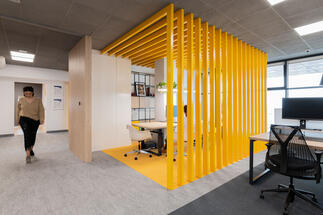Discussing the organization of office space and its impact on productivity, we spoke with architect Sonja Brstina from the portal Gradnja.rs, who has designed numerous such spaces in her career.
Sonja emphasizes that setting up an office is not just about arranging desks and chairs, but rather a creative endeavor aimed at ensuring employees feel satisfied, which in turn leads to increased productivity, the ultimate goal of investing in office interiors.
"That's why it's very important not only how offices are designed but also how common areas like canteens and conference rooms are conceptualized, as these are places where employees can exchange experiences and needs. The key factor in designing office space is comfort and creating a pleasant place to work. It's essential to create a space where employees want to spend their time," explains Sonja.
For this reason, she insists on functional rather than aesthetically pleasing spaces because, as she explained, forced solutions that emphasize aesthetics usually sacrifice functionality.
"Spaces are often cluttered with furniture, there are no defined movement lines between rooms, air conditioning blows in the wrong places, and they generally lack the charm that gives authenticity to the space. A beautiful detail actually arises from careful architectural consideration of the space and creating a functional solution where everything operates smoothly," she says.
Years of experience have taught her that in practice, when designing office space, one should avoid a monochromatic scheme.
"It's necessary to introduce color into the interior to give the space dynamism and playfulness. Usually, company colors or complementary colors are used, giving the interior a unique touch. It's important to know that earthy and pastel colors stimulate employee creativity, so I often use them in my projects," she explains.
This is supported by Boris Popov, a professor at the Faculty of Philosophy in Novi Sad, who points out for Forbes Serbia the effects colors have on our mood but also adds that this information should be taken with caution, as strong empirical support is still lacking.
"For instance, it has been shown that red increases energy and arousal levels, yellow can stimulate mental activity, and green and blue lead to relaxation. Specifically, green is most restful for the eyes and leads to attention restoration," says Boris.
Stressed-out rooms are becoming a trend A 2019 survey conducted by the job search company Monster.com showed that out of more than 3,000 respondents, almost 85 percent said they had cried at work at some point. A more recent survey by a temporary employment agency on a similar sample showed that 52 percent had lost their temper at work at some time.
Such situations have prompted the creation of "Stressed-out" rooms where employees are isolated from noise, allowing them to take a break or even scream if they feel the need.
Boris notes that this trend is slowly arriving in our region. These can also be meditation or wellness rooms and are usually part of the benefits employers offer their employees.
"Such rooms can have effects, as practicing meditation or mindfulness, as research suggests, can have beneficial effects on employees' mood, stress, and well-being. But what should be kept in mind here is that such rooms cannot compensate for low salaries, boring and monotonous jobs, toxic interpersonal relationships, poor management, and the like," he explains.
"Open space" areas or more intimate zones According to our interlocutors, interior design plays a significant role in productivity. Boris points out that it is well known that a view through a window facing a green environment—like a park or forest—leads to better mood compared to a window facing an urban area of the city.
"No matter what interior design is chosen, its impact should not be overstated. The way the job is organized, social support at the workplace, a culture of support, and psychological safety play a much more significant role in employee productivity," he says.
Additionally, our interlocutors suggested another important element when it comes to organizing office space. Although once popular, the so-called "open space" areas are increasingly being criticized today. There are many reasons for this.
"Open Space areas are controversial because, although they promised a lot, open offices bring more contradictions than initially thought. For instance, employees in such spaces complain about a lack of privacy, increased noise, and more distractions compared to traditional 'closed' offices," he says.
Sonja points out that unlike the previous "open-space" trend, employees are increasingly seeking more intimate workspaces.
"The open-space concept has been replaced by larger offices for up to ten people grouped by projects. Also, shared workspaces are becoming more prevalent, where employees change positions depending on needs. Clients are looking for the most flexible workspaces possible to best accommodate employees," says Sonja.
Choosing materials: Transitioning to eco-friendly options Climate change, tropical temperatures, and heavy rains have led to a shift towards eco-friendly solutions. Many companies, wanting to preserve their image and raise awareness of environmental issues, are increasingly turning to sustainable materials. This is also the case with the choice of materials in office space.
Not only do they make the space pleasant to stay in, but such materials are often easy to maintain.
"Recycled materials like acoustic panels and carpets made from recycled plastic bottles and other waste materials are increasingly used. Natural materials like veneers contribute to a more pleasant ambiance. It's important for the workstation, i.e., the desk, to be made of durable materials. Therefore, compact boards, which are durable, resistant, and easy to maintain, are mostly used," she explains.
It's also not a bad idea, as she explained, to put sound-absorbing materials on the walls and ceilings, and care should be taken with lighting, especially if it's an office with glass partitions. These, she says, are good because they open up the space, but on the other hand, care should be taken with their placement because business spaces should not only be beautiful but also functional.
"However, for a good work atmosphere, it's important to choose lighting carefully, as it significantly affects the final impression of the interior. While warm lights are used in residential spaces, it's better to use cooler light of 4000K in business spaces to increase productivity. The lights must be well-distributed, so a lighting calculation is done to ensure each workstation has enough light," she adds.
Sonja usually designs projects herself, not only to make the most of every centimeter but also to meet client requirements.
"For instance, in one of my past projects, the client requested conference tables that would not allow anyone to sit at the head of the table. Part of the culture of a well-known Novi Sad company is that everyone at the table has the right to express their opinion and listen to others. So I designed a table with a triangular end. They were thrilled," says Sonja.


